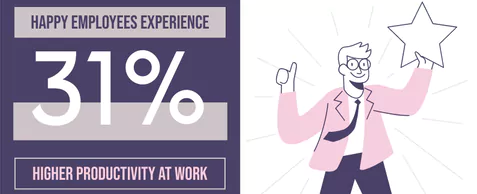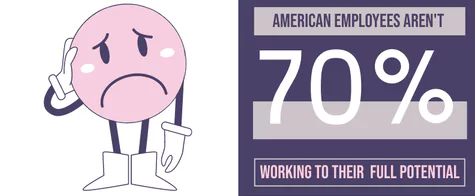
Employee engagement and motivation have become pressing issues for organizations across industries. With talent shortages, economic uncertainties, and evolving workplace dynamics, leaders must find ways to inspire their people amidst the chaos.
More than just perks and bonuses, employees now seek meaning, growth, and impact from their careers.
The old motto “work to live” has given way to “live to work.” Organizations that tap into this trend and ignite passion and purpose within their workforce can gain a powerful competitive advantage. They benefit from higher productivity, better retention, and increased innovation.
However, inspiring employee passion and purpose takes more than a few speeches. It requires a holistic approach across all aspects of company culture, from communication and recognition programs to professional development and corporate social responsibility initiatives.
When done effectively, these efforts can transform disengaged teams into motivated activists who drive the organization forward.
Defining Passion and Purpose
Before exploring strategies, let’s define what we mean by “passion and purpose” in the workplace context. Passion refers to genuine excitement, enthusiasm, and commitment to one’s work. Rather than just going through the motions, passionate employees care deeply about what they do and devote significant energy to it.
Purpose takes passion a step further by linking one’s job to meaningful impact and a sense of service beyond self. Employees with purpose understand how their roles contribute value to the bigger picture. They find inspiration not from the work itself but from advancing the organization’s vision.

If an employee is surprised with their workspace, his, or her productivity experiences a spike with 31%.
Together, passion and purpose create employee experiences marked by high engagement, satisfaction, and performance levels. Organizations must foster these attitudes across all workforce segments, from top executives to frontline contributors, if they want employees to reach their full potential.
Communication Starts from the Top
Cultivating passion and purpose starts at the top, with executive leadership defining a compelling vision and strategy. Leaders must first clarify where the organization is headed and why it matters before they can inspire teams to take up the cause.
Communication should center around three key points:
- Organizational purpose – What societal needs is the company working to address? How does it envision the future? What values guide decisions and operations?
- Strategic priorities – What goals and objectives will help advance the organization’s purpose over the next 3-5 years? How do various projects and initiatives tie back to these focus areas?
- Individual contribution – Given the strategy, what roles do specific departments, groups, and employees play in bringing the big-picture vision to life?
When leaders consistently reinforce these messages, they provide context around the deeper meaning behind individual jobs. This helps employees connect their day-to-day responsibilities to the pursuit of larger, motivating goals. Rather than clocking in to complete isolated tasks, people feel part of an integrated effort making an impact they care about.
Recognition Ties Effort to Impact
Along with communication, organizations seeking to motivate employees should implement modern employee recognition programs. Well-designed recognition programs reinforce purpose and passion by making clear links between an individual’s efforts and advances in the organization’s mission.
Public awards create opportunities to highlight contributions that exemplify strategic priorities in action. For example, a technology firm wanting to accelerate product innovation could use its employee recognition program to praise both major breakthroughs and quieter process improvements that demonstrate creative thinking. This shows workers at all levels how pursuing innovation in their daily efforts supports the broader vision.
Moreover, modern digital platforms enable peer-to-peer recognition that fuels organic employee engagement. When teammates notice and appreciate each other’s progress, it facilitates collaboration, bonding, and affirmation around the company’s shared goals.
Skills Development Aligns Jobs with Interests
Opportunities for continuous skills development and career growth reinforce workplace passion and purpose. No one takes a job expecting to stay in the same role forever. Employees desire professional progression that expands their capabilities and responsibilities.
Having clear paths to learn new skills and earn promotions keeps workers focused more strongly on the organization’s purpose by elevating their stake in achieving it.

A recent unfortunate study shows that almost 70% of American employees throughout the country aren’t working to their full potential.
Significantly, rather than defaulting to one-size-fits-all development programs, leaders should differentiate opportunities based on individuals’ strengths, interests, and goals. Personalized growth paths better support both the employee and organization alike.
Someone from finance may transition into a business partner role whereas a marketer explores a specialization in social media analytics.
Corporate Social Responsibility Brings Purpose Home
Finally, corporate social responsibility (CSR) represents one more lever for magnifying workforce passion and purpose. CSR refers to company programs and partnerships that aim to benefit environmental or social causes. Examples include volunteering events, matching charitable donations, sustainability initiatives, and more.
CSR efforts often have dual benefits – increasing employee pride and advancing the organization’s societal purpose. Uniting the workforce around service activities can powerfully strengthen cultural cohesion and camaraderie.
Moreover, when organizations “walk the talk” through CSR versus just talking about their mission, it reinforces dedication to the cause amongst employees.
Moving from Mission Statements to Mission Impact
Speaking of the current demanding talent landscape, organizations cannot afford disengaged workers clocking in to earn a paycheck. Attracting and retaining top employees requires cultures where people actively rally behind a shared mission larger than themselves. Workers want to feel their jobs matter.
Through ongoing communication, thoughtfully designed recognition programs, development pathways, and corporate social responsibility, leaders can transform bureaucratic roles into vocations brimming with passion and purpose.
The strategies discussed above help connect employees’ daily efforts to big-picture impact when advancing personal growth and fulfillment.